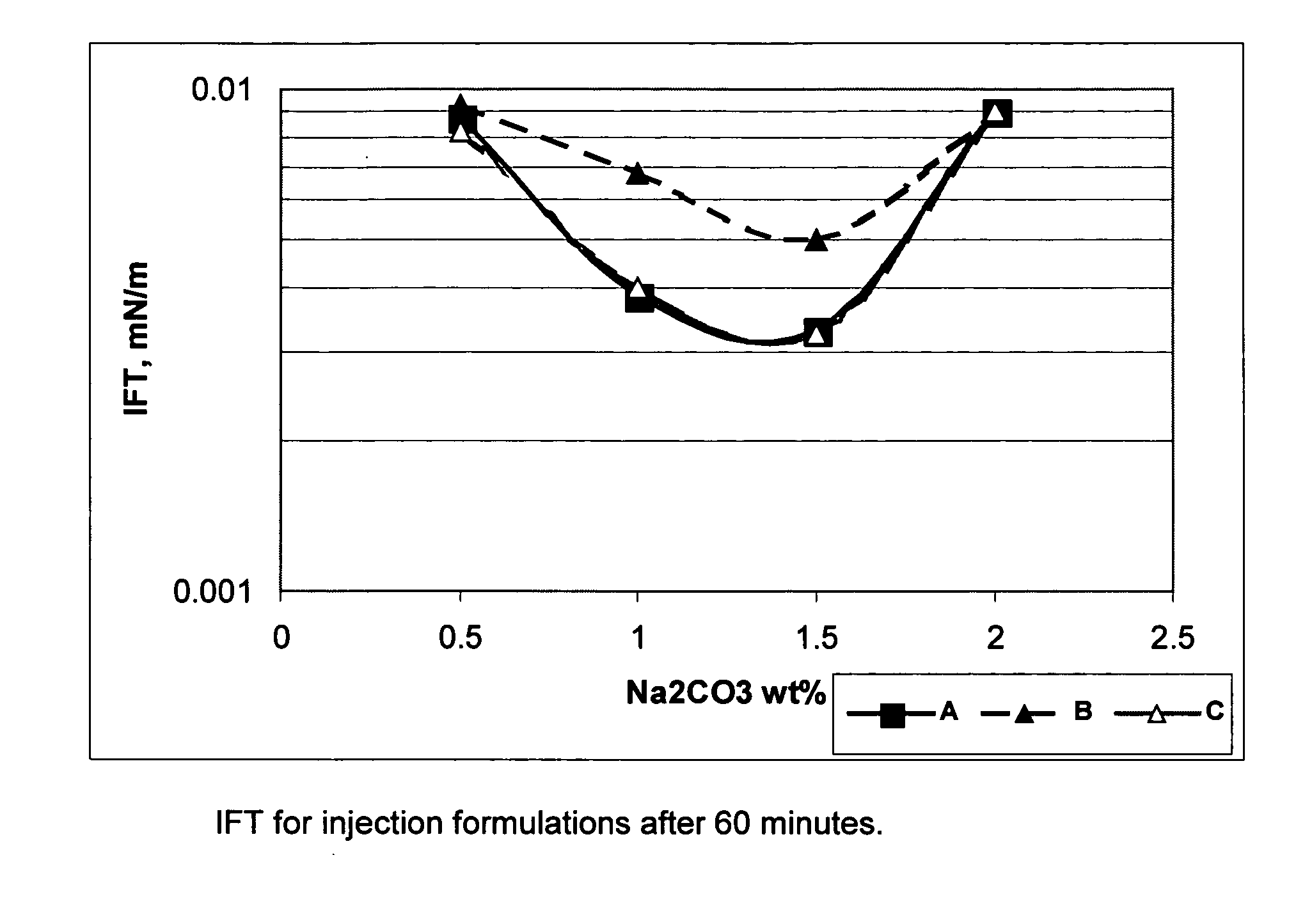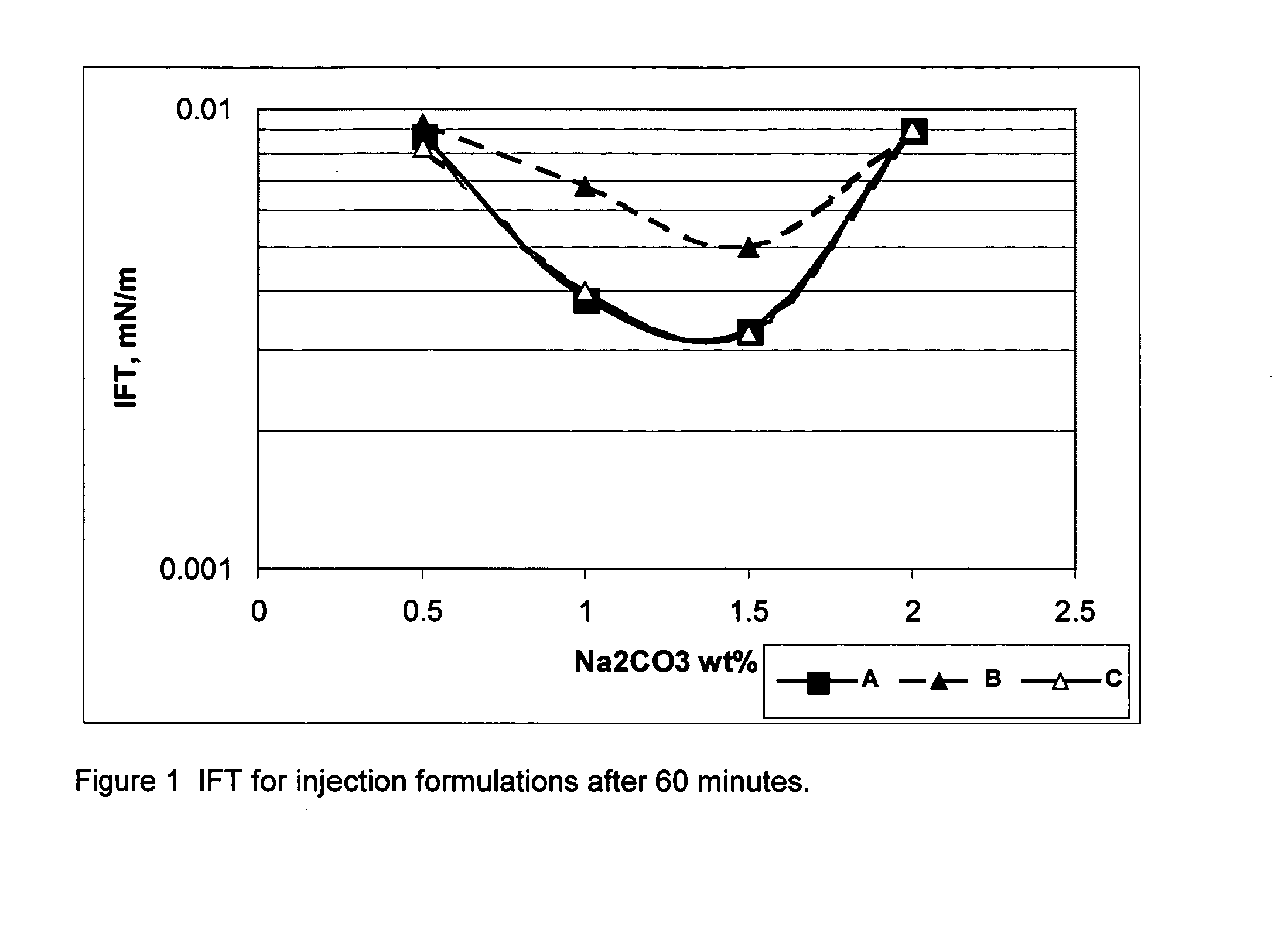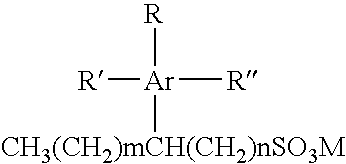Process for recovering oil from subterranean reservoirs
a technology of subterranean reservoirs and processing methods, applied in the direction of fluid removal, chemistry apparatus and processes, borehole/well accessories, etc., can solve the problems of increased costs, unsuitable surfactant stability in injection system and reservoir conditions, and difficulty in field application handling, etc., to achieve the effect of low cos
- Summary
- Abstract
- Description
- Claims
- Application Information
AI Technical Summary
Benefits of technology
Problems solved by technology
Method used
Image
Examples
example 1
[0042]This example demonstrates the effectiveness of the process using surfactant compositions containing arylalkyl sulfonates and various co-surfactants to reduce IFT over a wide range of crude oil and brine compositions.
[0043]Two different field conditions were chosen for testing. The field conditions are summarized in Table 2 and the surfactant formulation and the testing results are shown in Table 3. All values are in weight percent. The IFT was determined using a University of Texas Model 500 Spinning Drop Interfacial Tensiometer. The data shows that ultra low IFT is obtained for different field conditions using and one or more co-surfactants. This is very important in the area of EOR since every field condition is different and treating chemicals must be formulated for each case in order to provide the best results.
[0044]A sand pack study was performed by injecting 0.3 Pore Volume (PV) of each of formulations A and B into a column containing crushed formation core saturated wi...
example 2
[0046]This example demonstrates that, unlike alpha olefin sulfonic acid, internal olefin sulfonic acid, or alcohol ether sulfates; the aryl alkyl sulfonic acid used in the present invention is stable in acid form and therefore can be stored and shipped in concentrated form as the 100% acid and then formulated into the final formulation near the injection site to be injected into the reservoir using the process of this invention. This provide a logistic advantages over other acids used as surfactant intermediates.
[0047]C18 aryl alkyl xylene sulfonic acid was prepared by reacting 1-octadecene with sulfur trioxide (SO3) to form the C18 olefin sulfonic acid. This was further reacted with xylene according to U.S. Pat. No. 6,043,391 to form the C18 arylalkyl xylene sulfonic acid [CAS name 1-octadecenesulfonic acid, (dimethylphenyl)-]. Laboratory monitoring of this material for extended periods over 1 year show this material to be stable and therefore suitable for shipping and storage at a...
example 3
[0050]This example illustrates the ability to formulate the primary surfactant with other secondary surfactants to obtain low IFT values. The secondary surfactant in this case is the carboxylate of nonylphenol with 10 moles of ethylene oxide (EO). This product is available commercially as Emcol™ CNP-110 from Akzo-Nobel.
[0051]A formulation was prepared with the composition shown in Table 5.
TABLE 5Surfactant / co-surfactant compositionWeight %NaC18 aryl alkyl xylene sulfonate0.2Nonylphenol + 10 EO carboxylate0.2Ethylene glycol monobutyl ether0.1Partially hydrolyzed polyacrylamide polymer0.1Injection Brine (un-softened produced water)RemainderIFT, mN / m, 60 minutes @ 80° C. 0.0039Residual Oil Recovery, %63%
[0052]This formulation does not require alkali to give low IFT and therefore softening of the brine to prevent precipitation of Calcium and Magnesium salts is not necessary. The IFT at 35° C. after 60 minutes was 0.0039 mN / m and the oil recovery is 63%. The performance using this acid ...
PUM
| Property | Measurement | Unit |
|---|---|---|
| amphoteric | aaaaa | aaaaa |
| divalent metallic | aaaaa | aaaaa |
| structure | aaaaa | aaaaa |
Abstract
Description
Claims
Application Information
 Login to View More
Login to View More - R&D
- Intellectual Property
- Life Sciences
- Materials
- Tech Scout
- Unparalleled Data Quality
- Higher Quality Content
- 60% Fewer Hallucinations
Browse by: Latest US Patents, China's latest patents, Technical Efficacy Thesaurus, Application Domain, Technology Topic, Popular Technical Reports.
© 2025 PatSnap. All rights reserved.Legal|Privacy policy|Modern Slavery Act Transparency Statement|Sitemap|About US| Contact US: help@patsnap.com



